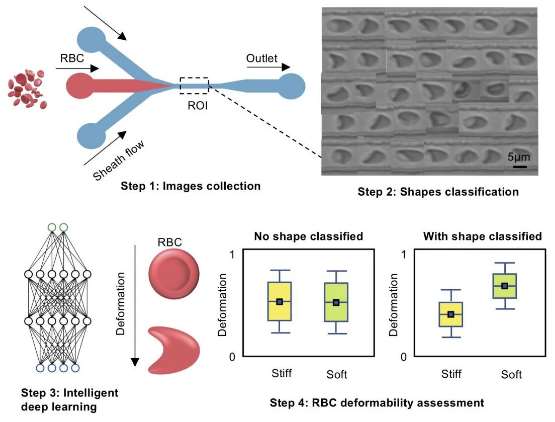
Singapore(ARN)— Using image-based deep learning and dynamic shape classification techniques, SUTD researchers developed a novel method of checking red blood cell deformability that is less invasive, more cost-effective, more sensitive, and has higher throughput.
Red blood cells (RBCs) transport oxygen throughout the body and are able to pass through a complex of narrow capillaries due to their ability to deform. “The deformability of RBCs is an important indicator of their health and functionality, and changes in this property can signal the presence of diseases,” said Associate Professor Ye Ai at Singapore University of Technology and Design (SUTD).
Improving current techniques to measure RBC deformability offers benefits in disease detection. By being able to detect RBC deformability changes early, patients can be diagnosed and treated earlier, improving their prognosis. Refined measurement tools will also aid researchers in understanding RBC deformability and its mechanisms better, possibly leading to new therapies.
“Overall, improving how RBC deformability is measured can lead to better diagnostic tools, enhanced monitoring of disease progression, and more effective treatments,” added Assoc Prof Ai, who led a study that developed the Image-based RBC Deformability Assessment via Shape-classification (IRIS) technology.
In the paper ‘Intelligent image-based deformability assessment of red blood cells via dynamic shape classification’, Assoc Prof Ai and his team present IRIS as a novel approach that can assess RBC deformability by classifying the shape of an RBC passing through a channel. IRIS uses deep learning and works in four stages: microfluidic setup, image capture, shape classification, and deformability assessment.
RBCs are first introduced into a microfluidic channel that mimics a blood vessel’s natural environment, and they become deformed. Images of the passing RBCs are then captured by a high-speed camera and processed by a deep learning model trained to identify and classify RBCs into six predefined shapes that represent different states of RBC deformation. Finally, the frequency and type of each shape under different conditions are assessed. This provides quantitative data on RBC deformability that can be used to check treatment impacts on RBC health and functionality.
Though IRIS is not the first technique to measure RBC deformability, its microfluidics-based technology offers many advantages over traditional techniques like optical tweezers and atomic force microscopy. With microfluidics, IRIS produces a much higher throughput than traditional single-cell based techniques, but can be automated and simplified, reducing manual work by trained operators.
Microfluidic devices require much smaller sample volumes and are more cost-effective compared to equipment needed in traditional techniques. Moreover, microfluidic systems are easily integrated into other tools and scalable for mass production. These advantages make such systems highly beneficial in widespread clinical and research settings.
Microfluidics also allows for the precise control of flow conditions in the channels, enabling detailed studies of RBC behaviour in different user-controlled environments. Most importantly, microfluidic techniques involve less cell manipulation, thereby reducing the chances of artificially changing the cell’s natural state, which can happen when atomic force microscopy and optical tweezers are used.
Another significant advantage of IRIS is its four-shape classification (4SC). Using 4SC compared to zero shape (0SC) or two-shape classification (2SC) results in higher sensitivity due to increased resolution of deformation states, better statistical power, and improved shape recognition accuracy. Essentially, 4SC classifies RBC into four shapes that include intermediate states of deformation. This provides a more refined view of RBC deformability compared to only classifying RBCs into two shapes (2SC) or none (0SC).
IRIS presents several benefits for use in clinical, therapeutic, and research settings. Gaining detailed information on RBC deformability enables early disease detection and diagnosis, while allowing personalised treatment plans for each patient. As a high-throughput method, IRIS is also useful in drug testing where large volumes of data are generated. Finally, the technology’s ability to precisely modify the RBC’s environment paired with its high sensitivity allows researchers to study RBC properties under various conditions, enhancing research and clinical capabilities.
Assoc Prof Ai aims to expand and refine the IRIS technology and to validate its results with clinical outcomes. Additionally, he looks at creating a portable IRIS to increase its accessibility and application scope. All in all, he foresees IRIS will become a reliable, effective, and accessible diagnostic tool in the long run.









